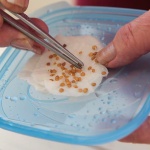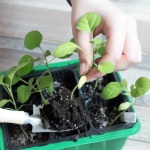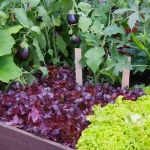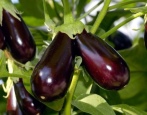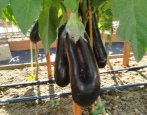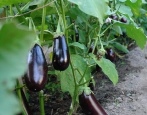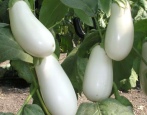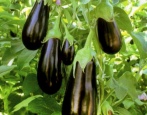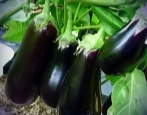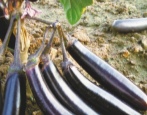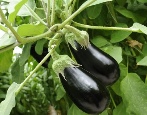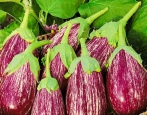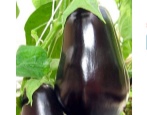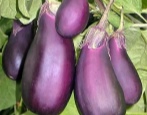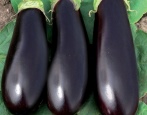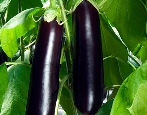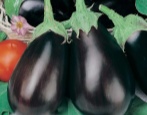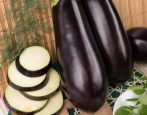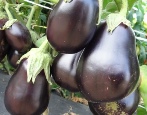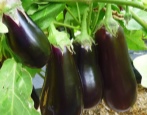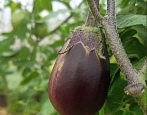
- Authors: Lukyanenko A.N., Dubinin S.V., Dubinina I.N.
- Year of approval: 2007
- Growth type: medium-sized
- Fruit size: large
- Fruit shape: flat-round
- Fruit weight, g: 400-500
- Yield: high yielding
- Fruit color: black-purple
- Keeping quality: suitable for long-term storage
- Ripening terms: early
Fans of exotic eggplant varieties will certainly like the Bourgeois hybrid with early ripening periods, which is characterized by unpretentious care and quick adaptability to growing conditions. Growing a vegetable is easy if you familiarize yourself with the intricacies of growing it.
Breeding history
Bourgeois is a hybrid of the first generation, created by scientists of the famous agricultural company "SeDeK" in 1995. The authors of the variety are breeders Dubinin S.V., Lukyanenko A.N. and Dubinina I.N. Eggplant is cultivated both on open ridges, and under a film shelter, and in greenhouse structures. You can grow a vegetable in any climatic zone, but it is most productive in the southern and central regions.
Description of the variety
The Exotic Eggplant is a medium-sized bush that looks quite powerful. The plant is characterized by a strong central stem with an intense anthocyanin color and weak pubescence, semi-spreading branches, moderate thickening of bright green foliage with purple veins, as well as a developed root system. There are practically no thorns on the cups.
During the flowering period, the bushes are covered with large lavender flowers. On one healthy bush, from 5 to 8 beautiful specimens ripen. The more fruits ripen, the smaller they ripen.
Characteristics of the appearance of plants and fruits
Bourgeois represents a class of large-fruited. The average weight of an eggplant is 400-500, sometimes 600 grams. The diameter of the fruit is about 10 cm. The shape of the vegetable is atypical for this vegetable crop - flat-round, resembling a flattened ball. Ripe eggplant is evenly covered with a black and purple tone. The peel of the vegetable is thin, but strong, elastic. The surface of the fruit is smooth, glossy, sometimes with noticeable ribbing.
Ripe vegetables can be transported well over long distances, and they also have a long shelf life if the correct storage conditions are provided.
Purpose and taste
Eggplant Bourgeois has excellent taste. The whitish-creamy flesh has a firm, delicate structure without wateriness and fibrillation. The taste of the fruits is pleasant, delicate, slightly oily, without bitterness and foreign aftertaste. The cooked vegetable has a characteristic mushroom flavor.
The harvested crop has a wide range of uses in cooking - hot and cold dishes are prepared from eggplants, they are pickled, frozen, baked, canned. The Bourgeois hybrid is ideal for stuffing with cheese or meat filling.
Ripening terms
Bourgeois is an early ripe hybrid. The growing season lasts 105-110 days. The fruiting period of the hybrid is long. Mass production of fruits lasts from the last week of July to mid-autumn. It is recommended to remove the fruits on time, without overexposing, as the taste may deteriorate and the seeds harden.
Yield
The hybrid is declared as a high-yielding hybrid.The average yield is 4.7 kg per 1 m2 of plantings. In greenhouses, yields are higher - 7-10 kg / m2. The maximum figure reaches 15 kg per 1 m2.

To get a tasty and bountiful eggplant crop, you must first grow strong and healthy seedlings. This culture is considered very capricious, therefore, you need to take care of seedlings when growing at home as correctly and carefully as possible.
Landing scheme
When cultivating eggplant, you should adhere to the basic planting rules, observing the distance between the plantings, as well as the density. It is recommended to plant 2 eggplant bushes per 1 m2, no more. The optimal layout for planting is 40x70 cm.
Growing and caring
The vegetable is planted in seedlings. For planting, strong bushes are selected at the age of 60-65 days with 5-8 true leaves and a formed root system. Planting is carried out from mid-May to early June.
The agricultural technology of vegetable crops is standard - regular irrigation with settled water (every 5-7 days), fertilizing 3-4 times per season, alternating organic matter and mineral complexes, weeding and loosening the soil, mulching row spacings with hay, straw or sawdust, forming a bush in 1- 3 stems, obligatory garter to the trellis, pinching at the moment when the central trunk has grown to 30-35 cm, prevention of viruses and pest infestations.

Planting eggplant is one of the most important stages in growing. When choosing a place for eggplants in your area, it is important to remember that this culture should be in warm soil, constantly illuminated by the sun. The plant is also very fond of spacious, open spaces, since its roots can grow over sufficient areas.



Soil requirements
The vegetable is cultivated in light, fluffy, fertile soils with good air / moisture permeability. The soil should not be acidic and waterlogged, as this can cause a number of fungal infections.
Required climatic conditions
Bourgeois is a thermophilic plant, therefore it requires planting in sunny areas, where there is enough light and heat. It is recommended to plant the crop on plains or low elevations where there is always a draft barrier. Most often, acrylic becomes a reliable protection from the cold wind.
Disease and pest resistance
Eggplants have a pronounced resistance to a number of diseases - the cucumber mosaic virus, late blight, fusarium wilting. In addition, the bushes are often attacked by the Colorado potato beetle, aphids and mites, which will help get rid of insecticidal preparations.
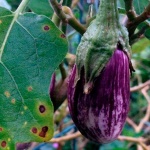
Eggplant is one of the most demanding crops.For its successful cultivation, it is necessary to create optimal conditions, as well as to carry out prevention and fight against diseases and pests. Eggplant often infects both fungal and viral diseases. If treatment is not started on time, you can completely lose the crop.
